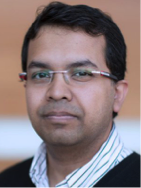Date
Cost
Free and open to the public
Location
Harris Corporation Engineering Center, Room 101A
Description
Abstract:
We live in the age of the information where electronics play critical role in our daily life. Traditional approaches for innovation in electronics have been inspired by Moore’s Law: performance with affordability. By leveraging suitable material properties of silicon, we have perfected complementary metal oxide semiconductor (CMOS) technology to achieve high performance, energy efficiency and ultra-large scale integration density in CMOS electronics. Moving forward as we embrace the Internet of Everything (IoE) where people, process, device and data will be connected – what would be the attributes of the electronics? What potential applications can augment the quality of our life which do not exist today? Is it possible to bring tomorrow’s applications to today’s society?
My research has been influenced by these questions. My continuing exploration suggests electronics in future will be ubiquitous in our life and seamlessly connected through internet. The attributes of the future generation of physical electronics will include: dynamic performance, ultra-low to self-powered operation (i.e. co-integration of energy harvesters), robust communication, live (data acquisition through sensors, data processing, storage, communication and decision execution through actuators will be heterogeneously integrated), democratized (easy to understand, simple to implement, use and affordable) and free form (physically flexible, stretchable and reconfigurable to conform to the soft tissue, irregular contour and asymmetric skin surfaces of living beings: from human and plants to animals).
While traditional CMOS industries have been advancing the classical features of performance, power consumption and scaling, the academic community has specifically focused on materials based innovation and low-cost fabrication processes. Ironically traditional CMOS materials like silicon, silicon germanium, germanium, III-V, gallium nitride, etc. are rigid and bulky; conversely emerging materials are still in the exploration phase and far from manufacturability for broad range of electronics. Thus, a balanced blend of scientific discovery and engineering innovation is an absolute necessity today. Therefore, our research is focused on hybrid integration of heterogeneous materials, processes and devices to build free form (flexible, stretchable, reconfigurable in shape and size) interactive and high-performance electronics and systems for smart living and a sustainable future focusing on healthcare, water, food and environment. For scientific exploration, we develop integration strategy to make collective use of the materials, processes and device architecture leveraging multidisciplinary tracks of electrical engineering, material science, bioengineering, computer science and engineering, mechanical engineering, environmental engineering (focusing plants and marine science) and health science. As engineering tool, we use CMOS technology extensively due to its industrial relevance, maturity and reliability for rapid tech transfer. In my talk, I will discuss the advances we have made which are under active commercialization by industries who are giants in their respective fields but not in the area of electronics. My examples will include: (i) advanced electronic systems for personalized healthcare; and (ii) frebonics: physically reconfigurable geometry electronics for fundamental design change in infotainment gadgets, electronic appliances and advanced healthcare devices.
Biography:
Dr. Muhammad Mustafa Hussain (PhD, ECE, UT Austin, Dec 2005) before joining KAUST was Program Manager of Emerging Technology Program in SEMATECH, Austin. His program was funded by DARPA NEMS, CERA and STEEP programs. A regular panelist of US NSF grants reviewing committees, Dr. Hussain is the Fellow of American Physical Society (APS), Institute of Physics, UK and Institute of Nanotechnology, UK, IEEE Electron Devices Society Distinguished Lecturer, Editor-in-Chief of Applied Nanoscience (Springer-Nature), Editor of IEEE Transactions on Electron Devices, and an IEEE Senior Member. He has served as first or corresponding author in 86% of his 241 research papers (including 18 invited reviews, 19 cover articles and 104 journal papers). He has more than 50 issued and pending US patents. His students are serving as faculty and researchers in MIT, UC Berkeley, Harvard, Yale, Purdue, TSMC, KACST, KFUPM, KAU, and DOW Chemicals. Scientific American has listed his research as one of the Top 10 World Changing Ideas of 2014. Applied Physics Letters selected his paper as one of the Top Papers of 2015. He and his students have received 36 research awards including IEEE Region 5 Outstanding Individual Achievement Award 2016, TEDx 2017, Outstanding Young Texas Exes Award 2015 (UT Austin Alumni Award), US National Academies’ Arab-American Frontiers of Sensors 2015, 2016, DOW Chemical Sustainability Challenge Award 2012, etc. His research has been highlighted extensively in international media like in Washington Post, Wall Street Journal (WSJ), IEEE Spectrum, etc. His research interest is to expanding the horizon of CMOS electronics and technology for futuristic applications.
Contact:
Saiful Khondaker, Ph.D.
Associate Professor
NanoScience Technology Center
Email: saiful@ucf.edu
Presenter

Dr. Muhammad Mustafa Hussain
IEEE Electron Devices Society Distinguished Lecturer
Associate Professor, Electrical Engineering
Computer Electrical Mathematical Science and Engineering Division
King Abdullah University of Science and Technology (KAUST)
More information
Light refreshments will be served